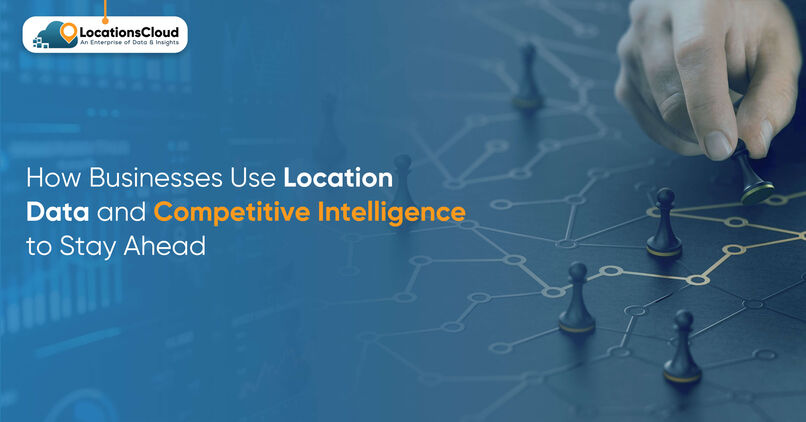
In the contemporary business world, which is fast-paced, intuition or conventional market analysis cannot help one to stay ahead of competition. The use of location data and competitive intelligence is becoming a common tool that businesses use to make the right decisions, discover new trends, and reach the right audiences. When these insights are combined with media intelligence solutions, companies are able to have a holistic picture of the market landscape, and eventually grow and enhance operational efficiency.
Using Location Data to gain Strategic Advantage
Location data can give businesses practical information regarding the location of their customers, their movement, and the motivation of their purchasing patterns. An example is retailers being able to study foot traffic trends to maximize the location of the stores, and logistics firms being able to optimize routes to save money. Through a combination of location intelligence and media intelligence platforms, the companies will be able to monitor the local trends, potential market, and regional consumer preferences.
As an illustration, a retail chain can track local trends in social media and location to determine what products are becoming popular in particular areas. Using this data together with the information provided by media monitoring solutions, they will be able to adjust their marketing campaigns to fit the local demand and have a higher chance of customer engagement and sales conversion.
Competitive Intelligence: Keeping ahead of the Competitors.
Competitive intelligence is not just knowing who your competitors are, it is knowing their strategies, positioning in the market and customer feeling. Many different media intelligence tools are used by businesses to gather and analyze this information, including tracking of competitor media mentions to their online campaigns. A media intelligence platform is able to bring together information on various sources such as social media, news media, and industry reports and give companies a clear image of competitive forces.
As an example, social media intelligence can help companies to track customer response to a new product release by a competitor. In case of any dissatisfaction or unmet needs, the business can modify its own products to exploit these gaps. On the same note, media monitoring solutions enable the organizations to monitor changes in the market mood, detect new threats, and foresee the actions of competitors, ensuring that they are always ahead of the pack.
Incorporating Media Intelligence Services
Media intelligent services combined with location and competitive data enable businesses to make data-driven decisions in their marketing, operations, and product development. These services have sophisticated analytics functions, including sentiment analysis, trend forecasting, and influencer identification. Using these insights, companies can optimize their message, better target their customers and position their brands.
In addition, businesses are no longer relying on conventional applications such as Google Alerts. The current Google Alerts alternatives have more detailed monitoring whereby organizations can monitor niche media channels, industry-related news, and even competitor strategies in real-time. This increased visibility makes sure that businesses do not get caught up by any unexpected market changes or new opportunities.
Real-World Applications
- Retail and E-Commerce:
Retailers can use the combination of location data and social media listening to determine high-demand items in certain locations and stock them appropriately. Media intelligence systems aid in monitoring competitor promotions, and thus, competitive pricing strategies are implemented in time.
- Hospitality and Travel:
Location intelligence is used by the hotels and travel companies to forecast the tourist hotspots, whereas social media intelligence is used to forecast the customer preferences and trending experiences. This enables companies to customize packages and marketing activities to the optimum.
- Financial Services:
Banks and fintech firms are utilizing media intelligence solutions to track financial news, competitor strategies, and customer sentiment to make more informed investment decisions and risk management.
- Healthcare:
Hospitals and pharmaceutical firms use competitive intelligence and media monitoring to monitor healthcare trends, competitor innovations, and patient feedback to enable them to deliver services better and adopt new treatments quicker.
The Future of Location and Media Intelligence.
The combination of location information, competitive intelligence and media intelligence services is changing the way business is conducted. State-of-the-art AI-driven machine learning media intelligence tools can now offer predictive analytics, enabling companies to predict market trends, identify emerging threats, and opportunities to grow ahead of competitors.
Moreover, the incorporation of social media intelligence means that the business will be able to react in real-time to the needs of customers and changes in the market. This proactive strategy is essential in the current digital-first economy with agility and responsiveness being crucial in staying ahead of the pack.
Conclusion
Businesses in the age of data-driven decision-making can not afford to use traditional market research only. Through location data and competitive intelligence, which is backed by media intelligence platforms, media monitoring solutions and Google Alerts alternatives, organizations can have a strategic edge. These tools enable companies to be ahead of the pack in a competitive environment that is growing more and more competitive. Companies that adopt this combined model are in a better position to make informed decisions, streamline operations and attain sustainable growth.


